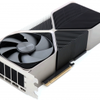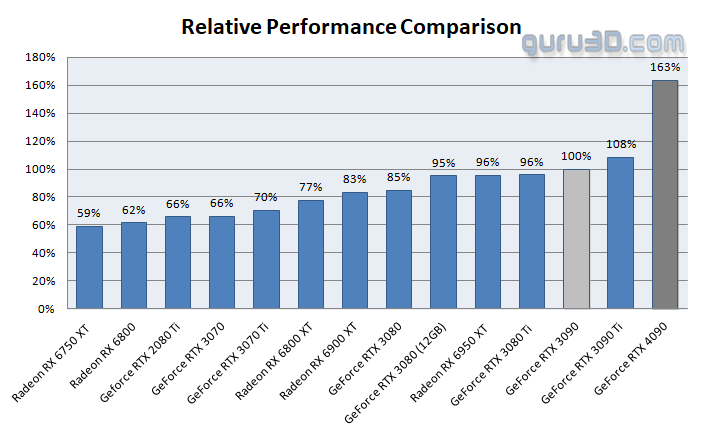Final words and conclusion
Final words
NVIDIA's new flagship has arrived (with GPU real-estate left for a SUPER or Ti). From a raw shader point of view this product offers a very handsome performance improvement over the last gen, we also can note down the massive increase in raytracing performance as well as added raytracing features of course. This round, NVIDIA is betting big on DLSS, though, with vastly improved Tensor cores that assist the new DLSS 3.0, currently quickly offering a 2x performance increase. With proper implementation of future games, NVIDIA claimed even a 3x or 4x increase in performance, these are staggering values. NVIDIA needs to fight two things, though; the first one is pricing. Starting at $1599, but more likely ending in the 2000 EUR range, these cards have become a product in a realm that hardly even is reachable anymore. Next to that, power consumption hovering at 450 Watts in times when energy prices have doubled/tripled doesn't exactly set the bar or good example of a company caring about the environment and cost to play; just sayin', of course. Trust me; it's a freakfest of performance, but granted, it's bitter-sweet when weighing these factors in.
Performance
Right, I spilt the beans already in the previous paragraph, but ultimately it is all about that gaming performance and, of course, rendering quality. Of course, the GeForce RTX 4090 is a product that does not need to make sense and cannot disappoint in that department, albeit we feel the RTX 4080 likely offers more value for money. We're nearing raw performance numbers that enable gaming at an 8K resolution; we can not check this for ourselves, nor do we find this relevant as most enthusiast gamers game at monitor resolutions of UWHD, QHD or UHD. You will often run into bottlenecks and CPU limits with a card like this at Full HD. But even there, some games with good programming and the proper API (DX12/ASYNC computation) reveal a good performance boost.
The old rasterizer engine breaks right through the previous limit of extreme performance. Because of the 16K Shading processors, all of this is possible. The RTX 40 series now has a new generation of Ray tracing and Tensor cores that are more powerful. So, do not let the specific RT and Tensor core counts fool you; it's all about how much performance one unit offers. Since they are close to the rendering engine, they have become more efficient, which shows. Tensor cores are harder to measure, but from what we have seen, everything seems to be in good shape, as DLSS3 shows breathtaking values. Overall, the GeForce RTX 4090 makes sense at resolutions as low as 2K 2560x1440,up-to 4K (3840x2160). As is usually the case when comparing apples and oranges, different architectures have different performance statistics because each architecture has its strengths and weaknesses in certain game render workloads.
Cooling & noise levels
The cooling design is fantastic, and 'it just works.' Keep in mind that the GeForce RTX 4090 is an enthusiast-class product with a high power consumption; under full load we measure this to be ~425 Watts for the founder edition (average). That Wattage directly relates to the amount of heat produced by the GPU, which on its end sits inside a closed chassis. For acoustics, we hit 39 dBA in highly stressed conditions, though it took a while for the card to get there (warms up slowly), but even that is considered an average to normal acoustic value. Under heavy load conditions, expect the card to close in at 70c; depending on the airflow inside your chassis, that value can increase. FLIR imaging shows nothing worrying.
Energy
We touched the topic a bit; the power draw under intensive gaming for GeForce RTX 4090 is significant, especially when energy prices are soaring; this product isn't a good example. We measured it to be close to the 425 Watt range. This is the tradeoff for a bit more bite in performance for this graphics card model in particular. Gaming wise that number will fluctuate a bit, however, 300+ Watt it'll do in no time. We expect the board partner cards to show higher numbers as they get more TGP allowance.
Coil whine
Much like the 3090, the GeForce RTX 4090 does exhibit coil squeal. Is it annoying? It's at a level you can hear it. In a closed chassis, that noise would fade away in the background. However, with an open chassis, you can hear coil whine/squeal. Graphics cards all make this in some sort or form, especially at high framerates this can be perceived. It's as good as it can get though and we have not been bothered by it.
Pricing
The reference/founder edition GeForce RTX 4090 from NVIDIA costs USD 1599; for most of us too much for something you can use to play PC games with. This product is so unique that it fills a niche all by itself. NVIDIA probably could have priced the product even higher and still sold many of them. AIB cards will likely cost even more. Now, I can say all kinds of crude things about price levels, but these products will sell regardless of what I say.
Tweaking
Clock frequency and memory tweaks run fine, but the performance gain was often a little disappointing. Regardless the card tweaks well. The GPU constantly hits the power limiter at 500 Watts with the high +33% power limiter, so that's your first and quickest option to tweak. You get extra perf on the card's default power budget. The clock frequency can take a good +200~250 MHz extra. Apply it, and you'll see the GPU boost clock hovering in the 3000~3050 MHz domain (frequencies vary per game title as they are dynamic). The memory could be tweaked to 22 Gbps, so all these are terrific values that brought ~5% additional performance on challenging GPU situations, measured from founder edition reference performance. However, +33% made the graphics card consume levels of 500W, we're not confident that 33 % of extra wattage is worth ~5% of extra performance.
Conclusion
From a technological point of view, the GeForce RTX 4090 is a bit of a masterpiece and an enigma. It feels bizarre to talk about products that consume 425~450 Watts (nearly half a Kilowatt per hour of gaming) in times when people are concerned about heating their homes in the winter. Of course, when NVIDIA was developing this GPU, times were different as there was no war on the European border. When we look at performance per joule of energy, NVIDIA advanced bigtime though, so ADA architecture has a lot of potential to be energy friendly. My message to NVIDIA is simple: make an energy-efficient statement, and design a product that offers excellent gaming horsepower for as little energy as needed. For those who live in different parts of the globe, here in the EU, energy prices are closing in at 50-75 cents per KWh, in some parts of the content, even 95 cents per kWh. Enough said about that, though.
ADA GPU architecture can perform skillfully and excellently; the GeForce RTX 4090 is a powerhouse. A good chunk of extra shader cores, nearly double performance Raytracing and Tensor cores, and underlying technologies like Shader Execution Reordering (SER) and DLSS 3.0 make the new product and Series 4000 shine. The GeForce RTX 4090 AD102 GPU has 76.3B transistors; I mean, OMG, staggering numbers. Starting at $1599, yes, the price is an unfavourable factor, and the amount of energy used as explained, is also something to ponder about. Both are high for this product to make any sense. So for this graphics card to make any sense, you must play games in Ultra HD or at the very least start at a monitor resolution of 2560x1440. We also know that because the product is in a very narrow niche, the two negatives do not have to make sense to many of you as enthusiast components are a class of their own. Regardless of it all, I live and thrive on exciting technology; I like this piece of hardware inside a PC, though, because it is a magnificent product no matter how you look at it. The RTX 4090 will exhaust a lot of heat, so ensure you have a lot of ventilation. Also, it is big and heavy (2.2kg), and it still looks great, but you need to make sure you can fit this inside your PC. The performance, man, that performance, it is all good. Take Microsoft Flight Simulator 2020 combined with DLSS 3.0, you can fly at 100+ FPS in the highest resolutions now. Cyberpunk at UHD with raytracing and DLSS3 quickly passes 100 FPS. This purebred Ultra HD card shines in that area, whether shading (regularly rendered games) or hybrid ray-tracing + DLSS3 is used. This thoroughbred stallion needs a lot of power and will only cater to a small group of people. Should you buy this product? Well, from a more economical point of view, you would be better off with a to-be-released GeForce RTX 4070 or 4080. This can even be considered a colossal waste of money, but it's also a colossal product for your ownership and gaming experience. One central question remains; is the 4090 an attractive enough card for the general public? You'll be able to find one in retail in the south of the $1700 range if you go for an AIB card. In the end, the product impresses big time and will satisfy you for the years to come, but at significant cost and energy consumption.
Sign up to receive a notification when we publish a new article.
Or go back to Guru3D's front page
- Hilbert, LOAD"*",8,1.
Let me close with what, for me, was the most impressive experience during our testing In the video below DLSS3 enabled Microsoft Flight Simulator, a simulation where in the past, I'd fly at 30-40 FPS framerates .. where framerates now really are flying.



